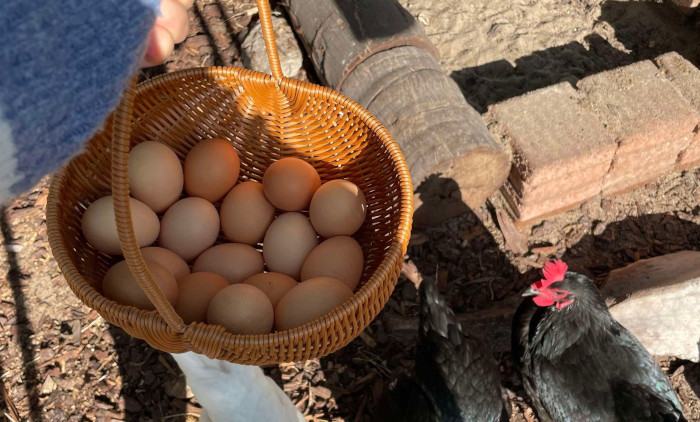I’ve been raising backyard chickens for awhile now, and through my experience, I’ve learned what makes a difference in producing high-quality eggs. If you’re getting into raising chickens, you’re probably curious about the best food to give your hens. After all, you are what you eat, and the same goes for chickens! It only makes sense to feed them the best so you can enjoy the best eggs.
Today, we’ll dive into the types of feed available and how to get those nice, bright yellow or orange yolks, along with delicious eggs.
Different Types of Chicken Feed
Scratch vs. Pellets
Scratch feed is meant to be used as a treat or supplement rather than as your chickens’ main feed. The ingredients in scratch mixes are generally less nutritionally complete compared to feeds designed for laying hens. Laying pellets and other mixes made for laying hens contain nutrients like calcium and protein, which they need to produce eggs.
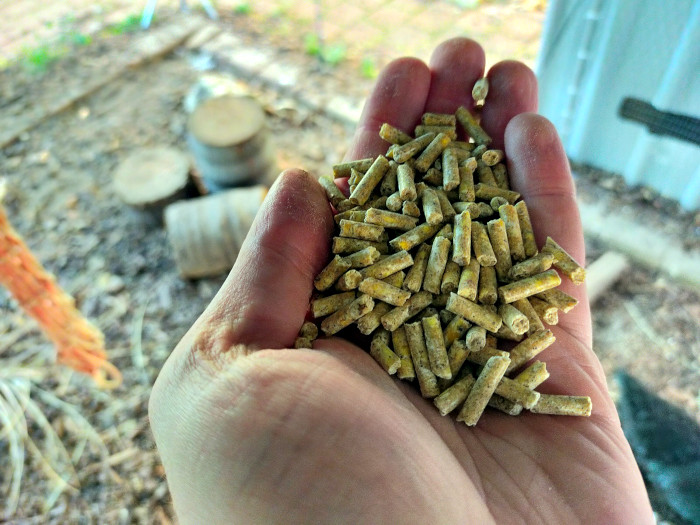
Free Ranging
You may have heard of pasture-raised chickens, which means they roam in fields, eating grass and insects. While this is great for their health and diet, it’s not sufficient to meet all of a chicken’s nutritional needs. Modern chickens have been bred to lay many more eggs than wild chickens, so they require additional feed like pellets to support their higher production levels.
The yellow or orange colour of the yolk comes from chemicals called carotenoids, found in plants. When chickens forage, they eat plants that contain these pigments, which change the colour of their yolks. If you don’t have access to pasture, you can still achieve this by feeding your chickens leafy greens.
Personally, I keep my chickens in a run attached to a shed I converted to a coop. The neighbourhood cats can be a bit of a menace so this helps protect them from the cats and other predators. I supplement their diet with leafy green scraps from our local shops.
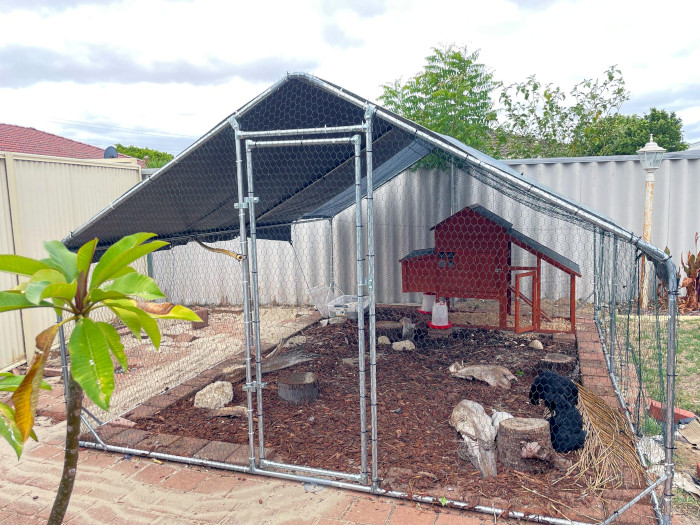
Nutrients and Their Impact on Chickens and Egg Quality
Providing your chickens with a balanced diet that has all the nutrients a chicken needs is crucial for their overall health and the quality of the eggs they produce. Here are the main things usually found in chicken feed:
Protein
Chicken feed comes in different protein percentages depending on the age and purpose of the birds. Starter feed for chicks has a higher protein content, while pullet feed is slightly lower, and for laying hens, 16-18% protein is ideal. I personally opt for 18% protein to ensure my chickens get all the nutrients they need.
Chicken feathers are mostly made of protein, and during moulting periods, they shed and regrow feathers, which requires a lot of protein. Chickens also lose feathers when stressed, such as during flock changes or predator encounters.
Another thing to keep in mind is that in the winter, chickens tend to forage less, meaning they won’t get as much protein from insects and plants. That’s why I choose to feed them a balanced diet with 18% protein year-round, ensuring they have enough nutrients to recover quickly, stay healthy, and produce high-quality eggs.

Calcium
Calcium usually comes in the form of crushed oyster shells or limestone, which is important for egg production. Without enough calcium, chickens can lay eggs with soft or thin shells, which can break easily. Occasionally, a chicken might accidentally break an egg during laying. In that case, you can bake and crush the eggshells to feed back to your chickens as a calcium supplement. Make sure to bake them at 120°C (250°F ) for about 10 minutes to sterilize and prevent disease.
It’s important to crush the eggshells thoroughly before feeding them back to your chickens. If they associate whole eggshells with food, they may start breaking and eating their own eggs.
Many laying feeds contain some calcium, but I prefer to provide free-choice access to a separate calcium source, like crushed shells, so they can pick at it when needed. This ensures they’re always getting enough calcium for strong eggshells and healthy bones.

Note: Too much calcium can affect the bones of non-laying hens, so adjust their diet accordingly.
Carbohydrates
Most feeds contain a mix of seeds and grains that give chickens the carbohydrates they need for daily functions like energy production, digestion, and maintaining body temperature. Carbohydrates are a main source of energy, helping chickens stay active, especially during colder months when they use more energy to keep warm. It’s important they have enough energy for laying eggs, foraging, and staying healthy year-round.
Vitamins and Minerals
Vitamins like A, D, and E, along with minerals such as phosphorus and magnesium, are important for overall health and egg quality. Most feeds designed for chickens contain these nutrients, so it’s not something to worry too much about if you’re using a quality feed.
How Much Food Do Laying Hens Need?
Your laying hen typically needs around 110 to 150 grams of feed per day (1/4 to 1/3 pound), depending on its size and breed. In winter, this amount may increase slightly as hens expend more energy to keep warm. For larger breeds, like Rhode Island Reds, aim for the higher end of the range—about 150 grams (1/3 pound) daily. Medium-sized hens, such as Leghorns, may require closer to 110 grams (1/4 pound).
It’s important to note that chickens will eat as much as they need, so I wouldn’t worry too much about the exact amount. Just make sure they have constant access to feed, and they will eat what they need to stay healthy. I find they tend to eat as soon as they get up and before they go to bed, the rest of the time they will just forage.

Transitioning Pullets to Laying Hens
When transitioning pullets to laying hens, you’ll find that they may have preferences for certain types of food, similar to adult hens. For example, when I transitioned from seed mix to pellets, I mixed them together initially, but one chicken preferred the seed mix and would scratch out the other food to get to the seeds.
Now, I opt for a hard transition. A hungry chicken will eat what you offer. While you can try mixing the old feed with the new and transitioning slowly—this can be effective for some—don’t hesitate to make a complete switch if you encounter difficulties. The hens will quickly adapt to their new diet, and this approach helps ensure they receive the proper nutrition necessary for egg production.
Automatic Chicken Feeder
A common chicken feeder works fine for feeding chicken but as you increase the size of the flock, refilling can become a bit of a chore. You can reduce this by using larger and more automatic systems.
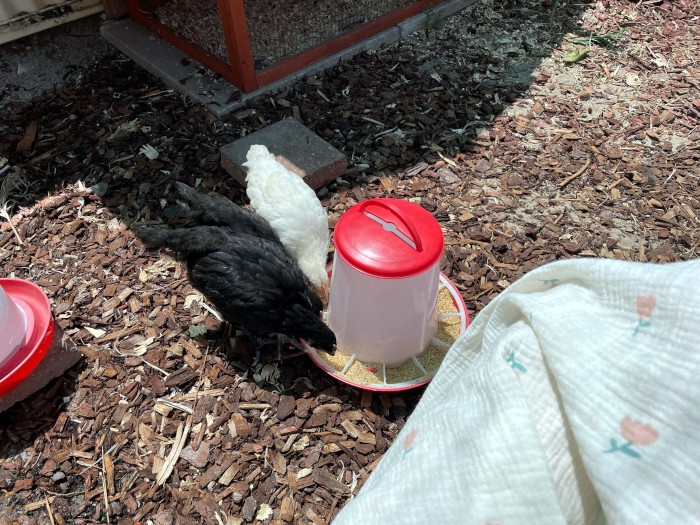
I use a bucket system to feed pellets to the chickens. It features some plastic components that allow you to fill the bucket without food spilling out. You can buy these plastic pieces online; just drill a hole and screw the piece in.

The design requires the chickens to put their heads inside, which helps reduce spillage and prevents moisture from getting in. The feeder uses gravity to refill until the bucket is empty. You can also increase the size of your container to extend the time between refills.

We currently have three chickens, and I find that the system lasts a few weeks before needing a refill.
FAQ
What Is the Best Feed for Different Breeds of Chickens?
For laying hens, a feed with 16-18% protein is standard for egg production. For meat birds, the protein is usually higher, around 20-24%, to help them grow faster.
How Can I Tell If My Chickens Are Getting Enough Nutrients?
Observation is key. Check their feathers—are they bright and healthy? Soft eggs are an obvious sign of calcium problems. How are they behaving? Are they lethargic or full of energy? These signs can help you work out whether your chickens are getting enough nutrients.
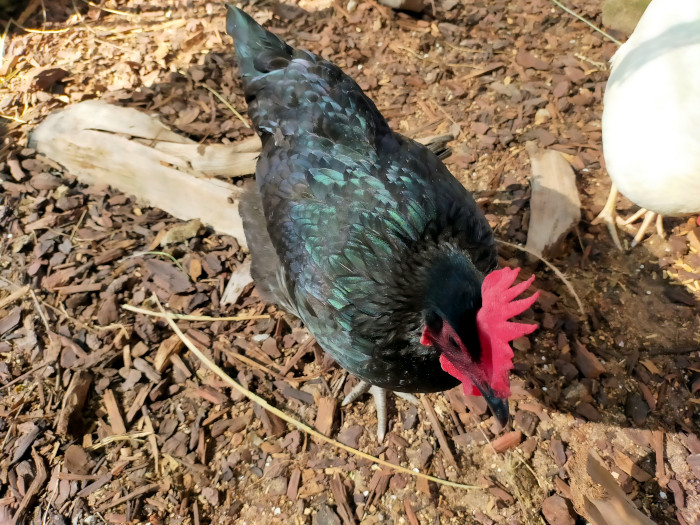
Conclusion
Raising backyard chickens can be a rewarding experience, especially when you see the difference quality feed makes in their health and the quality of the eggs they produce. By understanding the nutritional needs of your hens and giving them with a balanced diet, you can ensure healthy, happy chickens that will give you nutritious, high quality eggs.
What kind of feed do you give your chickens? Share with us in the comments below.
